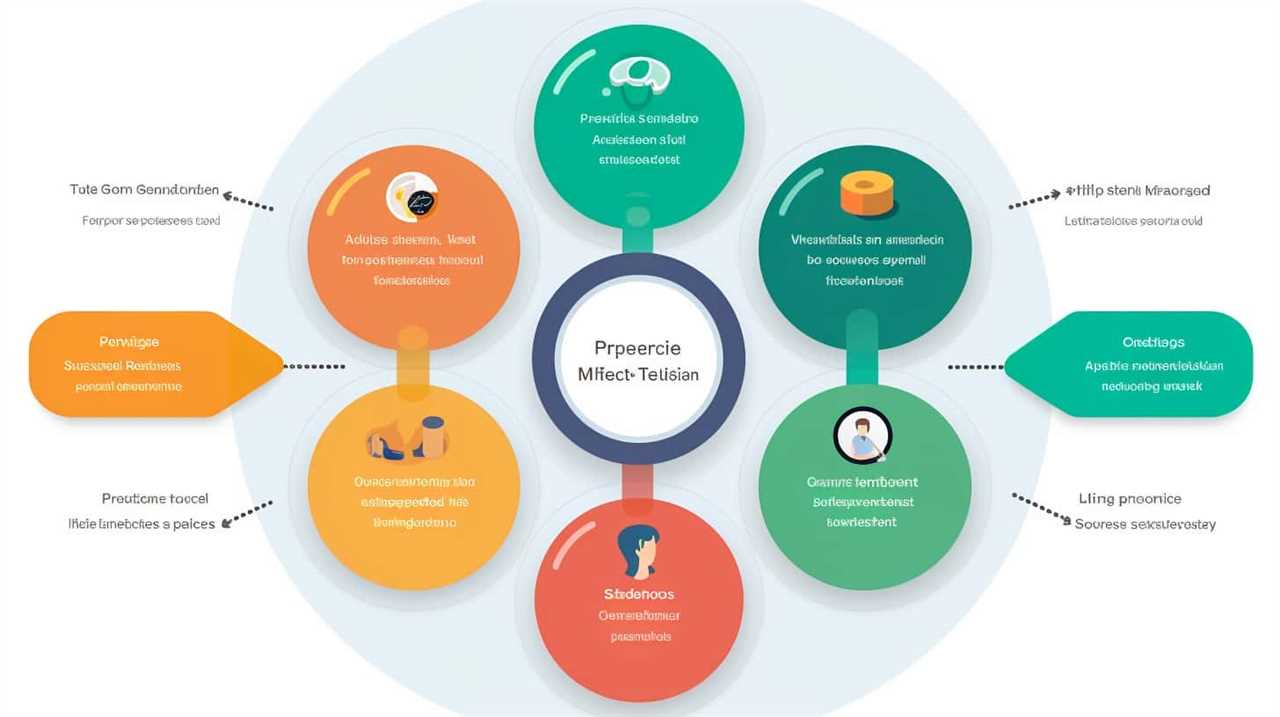Seeking ways to enhance your content quality? Look no further! As SEO experts, we’ve compiled a set of strategies aimed at amplifying your content’s overall effectiveness.
By implementing proper keyword research and optimization, optimizing for readability, and incorporating engaging headlines, you can elevate your content to new heights.
Additionally, utilizing external and internal linking structures, enhancing user experience, and optimizing for mobile can significantly boost your search visibility.
Join us on this journey towards content liberation!

Key Takeaways
- Keyword research and optimization is crucial for enhancing content quality as it helps in identifying relevant and valuable keywords to attract organic traffic.
- On-page optimization techniques such as improving typography, optimizing images, using subheadings, and formatting with bold and italics improve readability and make the content more engaging.
- Crafting compelling and keyword-rich headlines, writing attention-grabbing meta descriptions, and utilizing social media for content promotion are effective in optimizing search engine visibility and driving engagement.
- Incorporating relevant and authoritative external links and implementing proper internal linking structure help boost credibility, enhance content quality, and improve user experience.
Keyword Research and Optimization
We use various SEO techniques to enhance content quality, and one of the most important ones is conducting keyword research and optimizing our content accordingly.
Keyword research involves analyzing the search terms that users enter into search engines and identifying the most relevant and valuable keywords for our content. This process includes competitive analysis, where we study our competitors’ keywords to gain insights and identify opportunities.
Additionally, we focus on incorporating long tail keywords, which are more specific and have less competition, allowing us to target a niche audience and improve our chances of ranking higher in search results.
By optimizing our content with the right keywords, we can attract more organic traffic and increase our visibility online.

Moving forward, let’s explore the next section about on-page optimization for better readability.
On-Page Optimization for Better Readability
To improve the readability of our content, we focus on implementing on-page optimization techniques. Here are five key techniques we use to enhance the readability of our content:
- Improving Typography: We select fonts that are easy to read and optimize the font size and line spacing to ensure comfortable reading experience.
- Optimizing Images: We make sure that images are properly sized and compressed to improve page loading times and avoid distracting the reader.
- Using Subheadings: Subheadings break up the content and make it easier for readers to scan and find the information they need.
- Utilizing Bulleted and Numbered Lists: Lists help organize information in a concise and structured manner, making it easier for readers to absorb key points.
- Formatting with Bold and Italics: We use these formatting options to emphasize important words and phrases, making them stand out to the reader.
Creating Compelling and Engaging Headlines
Our team focuses on crafting compelling and engaging headlines to enhance content quality. Writing effective meta descriptions plays a crucial role in attracting readers and improving search engine rankings.
A well-written headline not only grabs attention but also entices readers to click and read the entire article. It should be concise, informative, and keyword-rich to optimize search engine visibility.

Utilizing social media for content promotion further amplifies the reach of your headlines, generating more clicks and shares. By incorporating relevant keywords and appealing to the interests and desires of your target audience, you can create headlines that captivate and drive engagement.
Incorporating Relevant and Authoritative External Links
When it comes to enhancing content quality, one technique that we should consider is incorporating relevant and authoritative external links. By linking to reputable sources, we can provide additional information and support our claims, which ultimately boosts the credibility of our content.
Not only does this help to establish trust with our audience, but it also signals to search engines that our content is valuable and reliable.
Linking to Reputable Sources
Incorporating relevant and authoritative external links enhances the quality of our content by building credibility and providing valuable resources for readers. By linking to reputable sources, we ensure that our audience can evaluate the credibility of the information we provide.

Here are five key benefits of linking to reputable sources:
- Enhanced credibility: By linking to reputable sources, we show that our content is well-researched and based on reliable information.
- Access to expertise: External links allow readers to explore more in-depth information from authoritative sources, expanding their knowledge on the topic.
- Verification of facts: Linking to reputable sources helps us ensure that the information we present is accurate and up to date.
- Increased reader trust: Providing external links to reputable sources builds trust with our audience, as they know we’re committed to delivering reliable information.
- Support for our arguments: Incorporating external links to reputable sources strengthens our arguments and adds weight to our content.
Boosting Credibility With Links
To further bolster our content’s credibility, we should continue by incorporating relevant and authoritative external links that enhance the quality and reliability of our information. Building backlinks from reputable sources not only improves our SEO, but it also increases our domain authority.
By including links to high-quality websites that are relevant to our content, we show that we’ve done our research and support our claims with evidence from trusted sources. This helps to establish us as a credible and reliable source of information in the eyes of our audience.
Additionally, linking to authoritative websites can also improve our search engine rankings, as search engines consider these external links as a signal of our content’s quality.

Implementing Proper Internal Linking Structure
When it comes to implementing a proper internal linking structure, there are a few key points to consider.
First, optimizing anchor text can greatly enhance the SEO value of your content and improve its visibility in search engine rankings.
Additionally, strategically interlinking relevant pages within your website can boost the authority of individual pages and improve the overall credibility of your site.
Lastly, a well-structured internal linking system can greatly enhance the user experience by providing easy navigation and guiding visitors to related content.

Anchor Text Optimization
By optimizing anchor text and implementing a proper internal linking structure, we can greatly enhance the quality of our content for SEO purposes. Here are five key benefits of anchor text optimization and proper internal linking:
- Improved user experience: By providing relevant and helpful internal links, we can guide users to more valuable content on our website.
- Enhanced crawlability: When search engine bots crawl our website, they use anchor text to understand the context and relevance of our content.
- Increased keyword relevance: Optimizing anchor text with relevant keywords helps search engines understand the topic and relevance of linked pages.
- Better search engine rankings: A well-optimized internal linking structure helps search engines discover and index our content, potentially boosting our rankings.
- Increased organic traffic: With improved search engine rankings and better user experience, our website is likely to attract more organic traffic.
Boosting Page Authority
We can significantly enhance our content’s quality for SEO purposes by implementing a proper internal linking structure that boosts page authority. Internal linking refers to connecting different pages within our website through hyperlinks. This not only helps users navigate our site more easily but also improves the search engine visibility of our content. By strategically placing internal links, we can guide search engine crawlers to important pages, improving their visibility and authority.
To understand the importance of internal linking in boosting page authority, consider the following table:
| Benefits of Internal Linking | How it Boosts Page Authority |
|---|---|
| Improves user experience | Increases time on site |
| Increases page visibility | Enhances crawlability |
| Spreads link equity | Improves backlink profile |
Improving User Experience
To optimize the user experience and ensure a seamless navigation flow, implementing a well-structured internal linking system is crucial. Here are five ways to improve site navigation and optimize image content:

- Create descriptive anchor text: Use relevant keywords in your internal links to provide clear context and help users understand where they’ll be directed.
- Prioritize important pages: Link to your most important pages from multiple locations on your website, such as the homepage or navigation menu, to ensure easy access for users.
- Use breadcrumb navigation: Incorporate breadcrumb navigation to show users their current location on your site and provide an easy way for them to navigate back to previous pages.
- Link related content: Connect related articles or pages through internal links to guide users to additional relevant information and encourage them to explore more of your content.
- Optimize image links: Use descriptive alt text and anchor text when linking to images, making it easier for both users and search engines to understand the content of the linked image.
Enhancing User Experience Through Mobile Optimization
Through mobile optimization, we can improve the user experience. Mobile design and website responsiveness are crucial factors in ensuring that users have a positive experience when accessing a website on their mobile devices.
With more people using smartphones and tablets to browse the internet, it’s essential to optimize websites for mobile devices. By implementing responsive design techniques, such as adjusting the layout and content to fit different screen sizes, we can ensure that users can easily navigate and interact with the website.
Mobile optimization also includes improving page load times, optimizing images, and simplifying forms for mobile use. By prioritizing the mobile experience, we can provide users with a seamless and enjoyable browsing experience, leading to increased engagement and conversions.
Now, let’s explore another technique for enhancing search visibility – utilizing schema markup.

Utilizing Schema Markup for Better Search Visibility
Implementing schema markup is an effective way to improve search visibility and enhance content quality. By utilizing structured data implementation and optimizing rich snippets, you can make your website more attractive and informative to search engines and users.
Here are five benefits of using schema markup:
- Increased visibility in search results: Schema markup provides additional information to search engines, helping them understand and display your content more accurately.
- Enhanced user experience: Rich snippets, such as star ratings and product prices, can make your listings more engaging and clickable.
- Improved click-through rates: With eye-catching rich snippets, your website is more likely to stand out among the competition and attract more clicks.
- Better targeting of search intent: Schema markup allows you to provide more specific details about your content, making it easier for search engines to match it with relevant user queries.
- Future-proofing your website: As search engines continue to evolve, structured data implementation will become increasingly important for achieving better search visibility.
Now, let’s move on to the next topic: monitoring and improving page load speed.
Monitoring and Improving Page Load Speed
We regularly monitor and improve our website’s page load speed to ensure optimal user experience and search engine performance.

Improving website performance is crucial as slow loading pages can lead to higher bounce rates and lower rankings in search engine results.
One way we optimize page load speed is by optimizing image files. Large image files can significantly slow down a website, so we compress and resize images without compromising their quality.
We also leverage browser caching, minify CSS and JavaScript files, and reduce server response time to further enhance page load speed.
Frequently Asked Questions
How Does Keyword Research and Optimization Contribute to Enhancing Content Quality?
Keyword research and optimization contribute to enhancing content quality by improving content relevance and SEO rankings. By identifying the right keywords, we can create valuable and targeted content that resonates with our audience and boosts our website’s visibility.

What Are Some Strategies for On-Page Optimization to Improve Content Readability?
Improving readability and optimizing layout are key strategies for on-page optimization. By implementing these techniques, we boost user engagement and reduce bounce rates. Let’s liberate our content from clutter and captivate our audience.
How Can Creating Compelling and Engaging Headlines Impact the Quality of the Content?
Creating compelling and engaging headlines plays a crucial role in enhancing content quality. It captures readers’ attention, encourages them to click and read further, and increases content engagement, leading to improved SEO performance.
Why Is It Important to Incorporate Relevant and Authoritative External Links in Content?
Incorporating external links from relevant and authoritative sources greatly enhances content quality. It boosts credibility, providing readers with valuable information and enhancing their trust. It’s crucial to prioritize credible sources in content creation.
What Are the Benefits of Implementing a Proper Internal Linking Structure for Content Quality?
Implementing a proper internal linking structure has several benefits for content quality. It improves user experience, helps search engines understand the website’s structure, and boosts SEO rankings. Best practices include using descriptive anchor text and avoiding excessive linking.

Conclusion
In conclusion, by implementing effective SEO techniques, content quality can be significantly enhanced.
These techniques include:
- Keyword research and optimization
- On-page optimization for readability
- Compelling headlines
- Relevant external links
- Internal linking structure
- Mobile optimization
- Schema markup
- Improved page load speed
These techniques act as the pillars that support a website’s visibility and credibility in search engines.
As the saying goes, ‘A well-optimized website is the key that unlocks the door to success in the digital world.’











